
Fishing rules vary by location, local laws
Fishing in the U.S. national parks can be a collectively enjoyable and relaxing activity as long as one plays by the rules. And there are many rules.
If one is to compare pictures of fish catch from 30 to 50 years ago to fish caught today, one difference is very apparent: the fish caught are quite small compared to what was caught in the 1960s and 1970s, and the amount caught is continually declining.
Before fishing regulations were imposed, licenses were not required and fishers were able to catch fish regardless of size or quantity. Catching large numbers of big fishes was easy with fewer people and more fish available. As the population increased, the number of fish could not complete with the number of people and, consequently, our forefathers unknowingly impacted the world of fishing as we know it today.
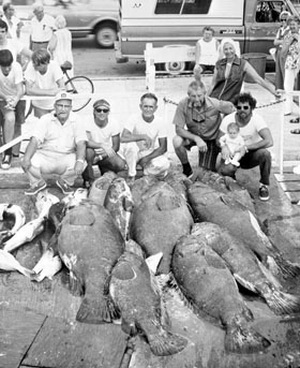 |
At left, a group assembled with its Goliath grouper in 1973. In the past there were no regulations on fishing (Photo by Art Stickel, courtesy of Florida Photographic Collection). Next, a Yellowstone National Park ranger with the native cutthroat trout (Photo courtesy of National Park Service). Next, a law enforcement park ranger checks for a fishing license (Photo courtesy of U.S. Fish and Wildlife Service). Next, a fisheries awareness class (Photo courtesy of the National Park Service). Last, fishing signs at Biscayne National Park (Photos by Yvette Jon). |
“Our forefathers’ fishing practices could possibly have been sustainable if the population stayed at what it was. However, with the rapid and tremendous increase in people fishing, combined with improved technology, the fish just don’t have a fighting chance,” said Vanessa McDonough, a fishery and wildlife biologist at Biscayne National Park in South Florida.
Today, laws regarding size and quantity limitations exist in order to give fish time to mature and reproduce and replace itself before it gets caught, said Scott Johnson, a law enforcement park ranger at Biscayne National Park.
A balance between resource protection and visitor use is necessary to ensure a healthy and sustainable environment.
McDonough said that balancing resource protection and visitor use is part of the park’s enabling legislation and the park’s mission, as the park is charged with protecting and preserving the resources of the park for use by this and future generations.
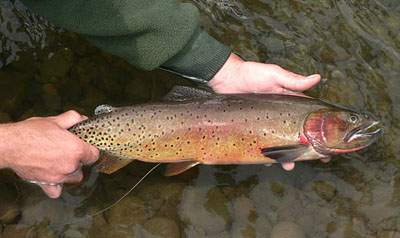 In a study completed in 2008 by Biscayne National Park, which includes Biscayne Bay near Miami and is 95 percent bay and ocean waters, the park repeated research conducted in the late 1970s and early 1980s where seven reef sites were visited and studied intensively in terms of what species were seen and how often they were observed.
In a study completed in 2008 by Biscayne National Park, which includes Biscayne Bay near Miami and is 95 percent bay and ocean waters, the park repeated research conducted in the late 1970s and early 1980s where seven reef sites were visited and studied intensively in terms of what species were seen and how often they were observed.
There was a loss of species diversity found on all seven sites ranging from 10 to 30 percent missing from the reefs. For example, seven years ago, the Nassau grouper was observed in almost half of the dives on the reefs. Currently, the Nassau grouper has been observed in less than two percent of the surveys.
McDonough does not attribute the decline to just fishing, although one of the biggest stresses is fishing.
“There’s just so many people out there fishing now, so with more population growth, there’s more effort,” said McDonough. “We also have to consider things like habitat destruction, boats running aground, water pollution–shoreline development certainly isn’t helping, and sedimentation and the like.”
Fishing regulations will vary from park to park and they are lengthy and complicated, so visitors are strongly encouraged to review the regulations before fishing.
Park regulations may exist in addition to state regulations. Informational content on regulations as well as seasonal fishing information can be found on the website of the particular national park, in visitor centers and ranger stations as well as state fish and wildlife websites. Visitors are also free to ask park rangers about the fishing rules and regulations.
In most national parks where fishing is permitted, a state license is required in order to fish within the park.
At Yellowstone National Park in Wyoming, where state licenses are not required, only a fishing permit issued by the park is mandatory.
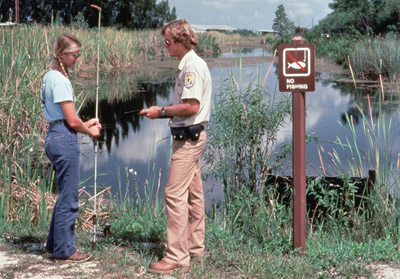 At Padre Island National Seashore in Texas, individuals who wish to keep their catch must purchase a fishing stamp for the appropriate fish species in addition to purchasing a license.
At Padre Island National Seashore in Texas, individuals who wish to keep their catch must purchase a fishing stamp for the appropriate fish species in addition to purchasing a license.
It is widely agreed by Joe Escoto, superintendent of Padre Island National Seashore, and Park Ranger and spokesperson Gary Bremen of Biscayne National Park that knowing the rules ahead of time will save a lot of hassle.
“With a federal park enforcing state regulations and some state regulations impacting only parts of the park, it can all get very confusing for everyone,” said Bremen.
Anthony Detmer, 22, who has been fishing since a young age, said he understands the regulations when it comes to fishing and releases his catch back into the water if he does not plan on keeping it.
“I fish for fun, but I know what I’m doing,” said Detmer, who sees plenty of fishers catching fish that are not of proper size and in large quantities. “If I catch a snapper that I plan to eat, I make sure that it’s the right size.”
Many visitors who fish do so recreationally. Johnson said that too often, visitors will catch and keep a fish that they will not eat for the sake of claiming that they have caught something.
“They didn’t even think about throwing it back,” said Johnson, who believes that if a fish is not going to be eaten, it should be released back into the water to reproduce so that it can be caught at a later time.
Commercial fishermen are not exempt either. Regulations will vary in terms of national parks allowing commercial fishing in additional to recreational fishing as well. For example, commercial fishing is prohibited in Everglades National Park. Biscayne National Park hosts recreational as well as commercial fishing with valid license and commercial fishing is regulated by the state.
“Trawling can be very damaging to the environment if the gear is not maintained,” said McDonough. “A properly running trawl should leave no impact or very minimal impact on the environment. But if the commercial fishermen are not keeping their gear in good order, it can really tear up the bottom, which then leads to [seagrass destruction] and destroying the habitat and the nursery grounds for a lot of these small fish that are important.”
Visitors should be aware of the areas within a park that are designated for fishing or where fishing is prohibited. Distribution maps within parks indicate where certain fish species grow, if not outlined in available regulation handbooks.
According to the Superintendent’s Compendium at Padre Island National Seashore, fishing is prohibited in Gulf waters east of the Malaquite Beach Visitor Center Pavilion between the southernmost and northernmost picnic shelters as fishing is incompatible with other visitor uses.
“This area is reserved for access of large crowds swimming and enjoying the beach,” said Jim Lindsay, chief of Sciences and Natural Resources at Padre Island National Seashore. “This ensures an area that visitors can swim without worrying about hooks and other fishing paraphernalia.”
Fishing too much and fishing in the wrong areas is one of the biggest problems, said Park Ranger Matt Johnson, who supervised the Fishing Bridge at Yellowstone National Park for four summers. Over the years, the Fishing Bridge was the source of much fishing activity until limits were instituted to keep the native cutthroat trout at a maintainable level because they couldn’t compete with the invasive lake trout. The take decreased every year and fishing was eventually closed off to that area.
“The Fishing Bridge is now [nick-named] the ‘No-Fishing Bridge’,” said Matt Johnson.
Visitors should also know which species can be fished, which species are catch-and-release only, and which species are prohibited from being fished. To fight off invasive species, visitors may also be told to kill fish.
For example, at Yellowstone National Park, all cutthroat trout, arctic grayling and mountain whitefish are catch and release only. They must be released if they are caught.
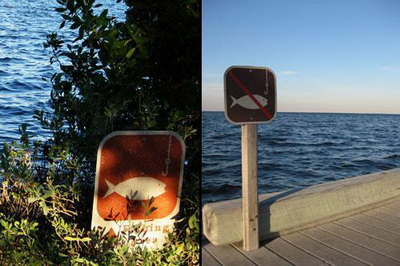 On the other hand, any lake trout caught in Yellowstone Lake, its tributaries and the Yellowstone River must be killed. Fishers who do not wish to keep the lake trout caught in these areas are told to “puncture the air bladder and drop into water as deep as possible.”
On the other hand, any lake trout caught in Yellowstone Lake, its tributaries and the Yellowstone River must be killed. Fishers who do not wish to keep the lake trout caught in these areas are told to “puncture the air bladder and drop into water as deep as possible.”
Taking into account the issues of overfishing as well as habitat loss and destruction, Congress passed the Magnuson-Stevens Act in 1996. The Magnuson-Stevens Act serves to provide for the conservation and management of fisheries, such as promoting catch-and-release programs and providing such standards for management plans to maintain optimum yields from each fishery.
Conservation and management measures found in fisheries management plans must be consistent with the standards set by the act.
As a result, regulations concerning fishing and the take of fish from national parks are most often established in coordination and cooperation with the state fisheries departments in which states the park is located.
The Federal Code of Regulations, which governs the use and management of national park system areas, states that “fishing shall be in accordance with the laws and regulations of the State within whose exterior boundaries a park area or portion thereof is located.”
With the exception of certain parks, these regulations apply to all parks.
Regulations are strictly enforced by law enforcement rangers throughout the park. Fines can go as high as $5,000 along with serving time in jail, and fishers can be cited for multiple violations. Law enforcement rangers conduct routine stops on a daily basis to ensure that fishers are following the rules, although it would be nice to think they can stop every single boat that passes by, said Scott Johnson, who must deal with enforcing state and federal laws at Biscayne National Park.
“First and foremost our goal out there is to protect and save lives,” said Scott Johnson. “If there’s something that needs to be done to meet that goal, we drop everything else to [attend] to that.”
In most cases, people don’t even know regulations exist.
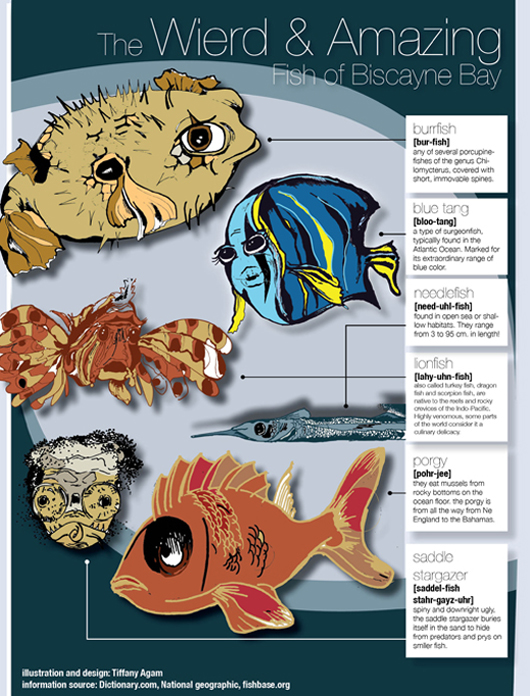
“Some people just aren’t even aware that there are rules so a lot of the violations we see are not people willingly violating the rules, but it is ignorance that there are rules,” said McDonough, citing common violations that include taking fish that are too small or fishing without a valid fishing license.
Biscayne National Park has a Fisheries Awareness Class (FAC) offered to first-time offenders. Similar to traffic school, the course is offered to fishers who receive fishing citations in order to understand the rationale behind regulations and become better educated anglers. Individuals may take the course in exchange for having their fine reduced or waived.
The class is also offered at no cost to the general public who are interested in learning more about fishing and preventing citations, but those who choose to take the FAC as a form of mitigation are required to pay a $50 fee to cover costs.
The class is educated on the basics of fishing such as identification, concerns regarding fish species, and the importance of knowing the fishing regulations, amongst other sections.
The class, which is offered in English and Spanish, has been 100 percent effective so far, said McDonough, as no repeat offenders have been found.
“We’ve encountered people out in the water after taking the class and they’re so happy to show us their catch and how everything is legal and they didn’t break any rules,” said McDonough. “They caught undersized fish and threw them back because now they know it was undersized.”
“It helps for people that don’t know who want to follow the rules and laws,” said Scott Johnson.
The National Park Service strongly encourages the catch-and-release method. In some parks, catching and releasing certain fish species is required as a method of conservation and management. This allows for fish to grow and reproduce, so fishers can have a larger selection of fish to choose from. The use of barbless hooks or artificial bait allow for easier handling of catch and release, and guidelines are provided if a visitor wishes to photograph the fish catch.
The fishing experience can be enhanced through the efforts of fishers to educate themselves about fishing and conserving fishery resources.
“In the past fishing was about catching as many fish as possible, without regard to damage to the fishery,” said Lindsay.“Most fishermen now realize that it is up to them to ensure that future generations have the opportunity to enjoy fishing.”
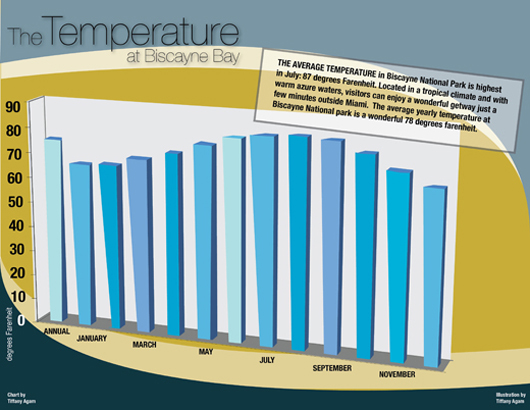
Changes to regulations occur, so visitors should be conscientious to check for updates on websites or newsletters.
Yellowstone National Park has a seasonal newsletter in which park regulations such as fishing are outlined, which can be found on the website of the national park. Likewise, since Biscayne National Park fishing regulations are consistent with those of the state of Florida, there also exists a seasonal edition of Florida Fishing Regulations issued by the Florida Fish and Wildlife Conservation Commission, where changes and updates to fishing regulations are reviewed.
In order to maintain sustainable environments, a Fisheries Management Plan (FMP) exists for certain parks. These plans outline potential changes to the park and intend to guide management decisions in an effort to conserve fishery resources over a given number of years. The Biscayne FMP works closely with the state of Florida in order to better protect and manage fishery resources and conserve fish stocks to ensure fishing opportunities.
“We want to establish resources that are healthy and sustainable and at the same time still allow people to fish,” said McDonough. “We don’t want to shut down fishing altogether, but we don’t want to let them keep fishing to a point where two generations from now there will be no fish left.”
Time must be taken into consideration, including the time it takes to make regulations addressing alternatives, the time it takes for the new legislation to have an effect, and even the time it takes for certain fish stocks to grow in order to meet goals.
Although it might be requiring a small sacrifice on today’s generation, McDonough said that in the long run the idea is that the FMP is going to make for a healthier, sustainable resource.
“There’s no point in having the largest marine park in the national park system if it’s just a bunch of trash reefs, garbage, pollution, and no fish,” said McDonough.
According to the Magnuson-Stevens Act, “Fishery resources are finite but renewable.”
Park visitors may contribute to the efforts of conservation by carefully following fishing regulations as well as promoting the catch-and-release method in a safe manner for present and future generations. This way, fishers can get the most out of their fishing experience and there will be an abundance of happy days in fishing.
Information graphics designed and prepared by Tiffany Agam.

Comments are Closed